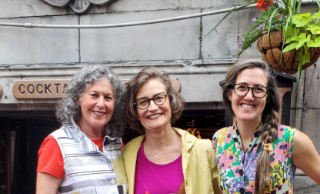By Helen Hirsh Spence
Estimated read, 3:48 min
Image: Left, Helen Hirsh Spence, Middle, Ashton Applewhite
During the past two months, I’ve had the unique opportunity to spend time with some of the most well-known and sometimes, outspoken, thought leaders in the age space who offered two entirely different learning structures for their respective events. It provided me with a new perspective on the meaning of collaboration and learning.
“Summer School” in Montreal, was organized by Ashton Applewhite, author of This Chair Rocks: A Manifesto on Ageism, and her co-creators, Ryan Backer and Kyrie Carpenter. Having registered for the event when it first was announced in June, I was fortunate to grab one of the limited spaces to attend.
Throughout early summer, we received updates on what to expect. However, the structure was rarely outlined. Having been accustomed to defined approaches to conferences and unconferences (participant-driven meetings), this made me slightly anxious.
On arrival in Montreal, it became clear that the 40 participants from around the world were in for a surprise. We were embarking on an “un-convening” governed by the principles of “liberating structures (LS)”, an unconventional structure designed to be inclusive and engage everybody.
Without going into great detail, it’s important to note that the innovative power that is traditionally in the hands of experts moves to participants when using LS. This methodology is made for relational coordination and trust, not to mention great innovation and productivity.
Imagine asking participants to consider what they would like to discuss over the next two and a half days along with the additional question “Who would like to facilitate this group?” It didn’t have to be the person who raised the topic but it could be. The 4-6 topics were listed on a whiteboard, facilitators were found, a room was assigned, and participants were let loose to find their preferred discussion group. There was no obligation to remain in the group if it didn’t suit their needs. They were instructed to use the “law of two feet” which meant leaving the room and attending elsewhere. After each 45-60 minute session, everyone reassembled in the main meeting room where 15 minutes were provided to write down our reflections.
And then it began again! The un-convening facilitators would go to the whiteboard to ask what we wanted to discuss next. The same process was repeated four times during the two days. There were many other activities built into the two days, too many to mention. I am only describing the core activity, discussions, here.
Imagine how unsettling the experience was at first. Chaos reigned. Were the rooms too big or too small to accommodate the varying sizes of groups? Who was leading this group? Did they know anything about the topic? People were running up and down the halls at Concordia’s Aging Institute, trying to figure out where to go. Amazingly, order ensued from the chaos and I don’t think anyone left the weekend with unkind or negative feelings about the process.
We had become the co-creators of the un-convening and it worked. The group shared resources, interests and strengths, and came up with actions to pursue. It was fascinating in that it necessitated trust in a process that was quite frankly a bit alienating at the start. Most importantly, it ensured everyone’s full participation resulting in meaningful outcomes.
In contrast, I was invited to speak on a panel at the American Association of Retired Persons (AARP) in Washington DC in the middle of September. Unlike the free-wheeling collaboration that occurred at “Summer School”, this Employer Summit was scheduled with precision. There were three panels, each with groups of three experts and a moderator. Lunch was extended for networking and a cocktail concluded the event. These two informal times and spaces facilitated greater connections among participants.
The format served this group very well, too. There was ample time to meet new people, make connections and pursue follow-ups. Its structure, however, wasn’t designed, nor was it intended, for collaborative purposes. AARP had information and resources to share. The LS design necessitated time and the intention to collaborate.
There is a time and a place for both traditional conference and liberating structure conference formats. LS is a grassroots movement that transcends personal, professional and interpersonal boundaries. It brings everyone in attendance together to share context and foster collaboration around problem-solving. Everyone has equal standing and becomes the expert because the traditional hierarchy doesn’t exist. Liberating Structures are inspired and informed by complexity science- the science of emergence. Who knew? But now that I know, I am eager to test it out!
If you would like more information, please reach out to me.
Helen


0 Comments